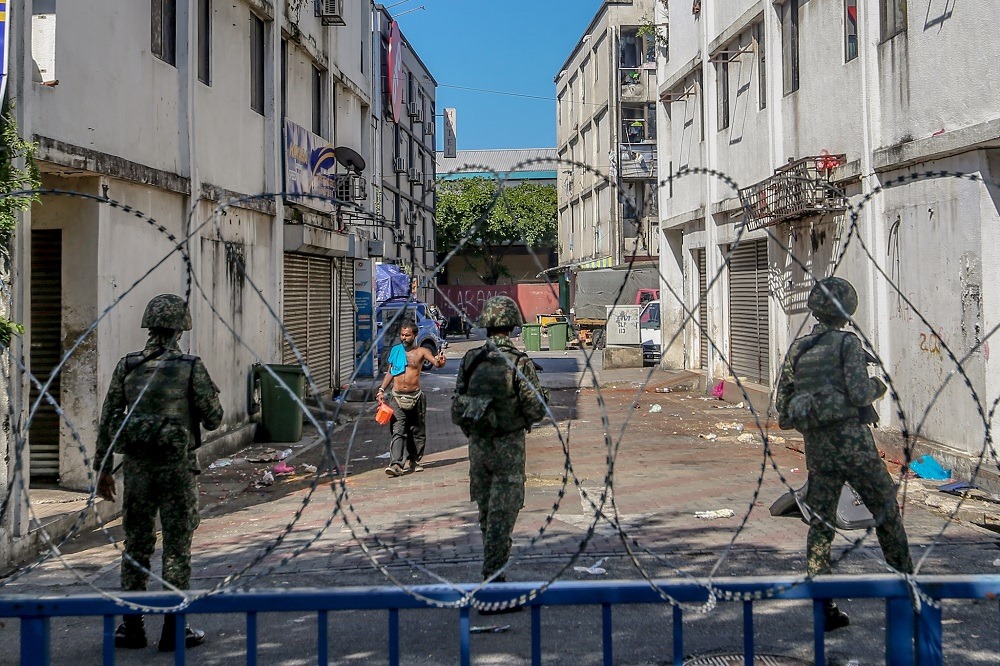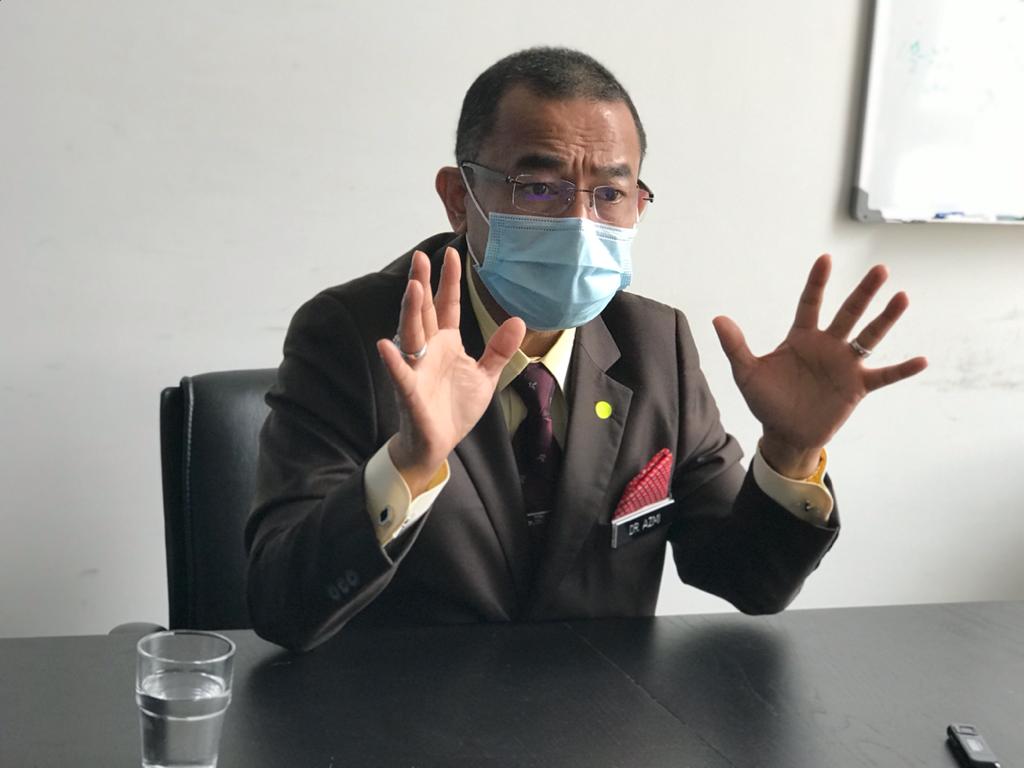KUALA LUMPUR, Nov 20 — Until a vaccine arrives, Malaysia will continue its current public health response of implementing lockdowns whenever Covid-19 cases rise rapidly, said Dr Noor Azmi Ghazali.
Subang MP Wong Chen recently told the Dewan Rakyat that it will take at least six months for the process of Covid-19 vaccine production, procurement, distribution, and inoculation. Hence, Wong said that the Malaysian epidemic may be curbed towards the fourth quarter of 2021, only if vaccines are purchased early and adequately.
“As far as we are concerned, where there is a high density of people and a surge of cases, then the Ministry of Health (MOH) will advice the government to do a conditional movement control order (CMCO), for example,” Dr Noor Azmi said in an exclusive interview when he visited CodeBlue’s office here yesterday.
“Whether we are going to do CMCO, or whether we are going to do recovery [MCO], or even to do targeted enhanced movement control order (TEMCO), it depends on the situation.”
Former Malaysian Medical Association president Dr Milton Lum recently highlighted the harms of lockdown, citing the International Monetary Fund that found lockdowns contributed to a global economic recession that affected vulnerable populations disproportionately.
Moreover, Dr Lum said that lockdowns also harm one’s health, either directly or indirectly. Citing a report published by The Lancet, he said that people under quarantine are most likely to develop symptoms like low mood, insomnia, stress, and anger, among others.
The former MMA president also highlighted how Argentina’s stringent lockdown since March, the world’s longest, had failed as the country recorded 1.273 million Covid-19 cases as of November 14 amid near economic collapse.
During his interview with CodeBlue, Dr Noor Azmi said that physical distancing and avoiding personal movement are the current measures that should be practiced, as there is no vaccine or medications yet for the new viral disease.
He stressed that the safest place to be is at home and people should limit their movements where possible.
“That’s why [if] for no big reason you get out, and [when you] do that, we have to do a CMCO,” Dr Noor Azmi said.
“At least we block people from travelling inter-state and inter-district. The less we do that, the better the outcome will be until the vaccine comes.”
Dr Noor Azmi Ghazali, Deputy Health Minister I
The CMCO implementation depends on the area, the density of the population, and whether there are sporadic cases or big clusters, Dr Noor Azmi said.
“For example, we see the last few days, wherever there’s a big cluster, then they will block everybody there,” the Bersatu lawmaker said.
Moreover, the Bagan Serai MP said that MOH sometimes advises the government to implement a CMCO even before an area becomes a red zone, like when there is a sudden surge of cases in an area.
MOH has labelled zones in Malaysia into four colours, based on the number of new local Covid-19 cases reported in the past 14 days. Previously, it was three colours — green, yellow, and red. Now, the ministry has increased the number of colours to four. Green is for no new cases reported in a district or sub-district for the past fortnight, yellow for one to 20 cases, orange for 21 to 40 cases, and red for 41 and above.
Dr Noor Azmi said he had asked for the orange zone to be included, as previously yellow zones meant new infections between one and 39.
“So, how do we make decisions between one and 39? Because that is two drastic things, you know,” he said, without elaborating on why those particular figures were chosen as indicators for movement restrictions.
Former Health Minister and Selangor Task Force for Covid-19 chairperson, Dzulkefly Ahmad, had previously asked why 40 cases were chosen as a threshold. Besides pointing out that the colour coding indicates clarity and makes it easy to differentiate between the zones, he asked if the case numbers are chosen based on any scientific inferences or consensus.
MOH Tests 10% Of Population In TEMCO Areas

Dr Noor Azmi also said that MOH’s approach in tackling the Covid-19 epidemic is targeted testing through active case detection and contact tracing, not mass testing.
He said that even in areas with targeted enhanced movement control order (TEMCO), where residents are kept at home, not everyone in those communities is tested.
“Those TEMCO areas, for example, the government will do, I think, if I am not mistaken, 10 per cent of the population. It’s not all; we don’t do all.”
“First of all, we can’t afford to do all. People might say do all 32 million people or something like that. That is not our approach; our approach is targeted.”
Dr Noor Azmi Ghazali, Deputy Health Minister I
On the other hand, Singapore has chosen the method of mass testing in curbing the infection, like testing all their migrant workers that contributed a major portion of their total number of Covid-19 cases, up to 85 per cent. Although Singapore reported a total number of cases is 58,130 as of November 18, over the past one week at least, the country has been reporting single digit cases with no locally transmitted infections.
From September 1 till November 14, Dr Noor Azmi said Malaysia has conducted 1,014,677 RT-PCR tests, with a testing rate of 69.41 per 1,000 population.
Apart from that, a total of 271,343 antigen rapid tests have been conducted all over Malaysia during the same time period.
CodeBlue also asked the deputy health minister if the government plans to change its public health strategy by testing more people and isolating positive cases quickly, even if this means detecting a much higher number of positive cases. Home surveillance can then be used for asymptomatic and mild patients, so that hospital beds can be reserved for stage three to five Covid-19 patients.
Dr Noor Azmi replied that when an individual is placed under a home surveillance order, people may break quarantine.
“If I put you three days in a room, then you (will) know. It is not three days; this is two weeks.”
He agreed that if more testing is done, then more positive cases will be detected because the virus is in the community. But he also said the main reason Covid-19 is in the community is because people are moving around.
Government Is Taking Care Of Livelihoods Despite Lockdowns

Dr Noor Azmi said that MOH is very careful with the decisions that they make to ensure a balance between life and livelihood.
“Whenever MOH makes the decision to advise the government, we always look at this. We don’t simply forget about people who cannot go to work, people got no income, losing their jobs.”
Many MPs, during their individual debates on Budget 2021 during the current Dewan Rakyat meeting, have shared stories on how many people have suffered because of the implementation of the CMCO.
Klang Valley has been placed under the CMCO for over a month since October 14; the CMCO on the country’s economic centre has been extended to December 6. The CMCO was also imposed on all other states in the peninsula, except for Perlis, Pahang, and Kelantan, from November 9 to December 6. Despite allowing people to go to work, movement restrictions have affected businesses severely, such as restaurants, as families cannot go out to have a meal together due to a limit of two passengers in cars and taxis or e-hailing vehicles.
Amanah president and former Defence Minister Mohamad Sabu shared with the Dewan Rakyat a story of how although CMCO has not been implemented in Pahang, an ikan patin restaurant owner in Temerloh, Pahang, had lost their income because of the Klang Valley lockdown.
Dr Noor Azmi, however, said during his CodeBlue interview that the government is always pumping in money to help the people, right from loan moratoriums to the Prihatin and Penjana economic stimulus programmes.
“Then, you see the Budget being tabled now, you see that so many things are given, including the KWSP [Employees’ Provident Fund account withdrawals], increase of moratorium [periods]. We are helping people because we know there are some people who are very much affected,” the Bagan Serai MP stressed.
“We know there are certain classes of people who are very much affected, while some people are not that much affected.”








